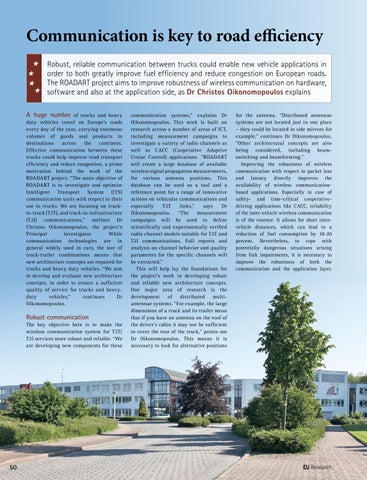Communication is key to road efficiency Robust, reliable communication between trucks could enable new vehicle applications in order to both greatly improve fuel efficiency and reduce congestion on European roads. The ROADART project aims to improve robustness of wireless communication on hardware, software and also at the application side, as Dr Christos Oikonomopoulos explains A huge number
of trucks and heavy duty vehicles travel on Europe’s roads every day of the year, carrying enormous volumes of goods and products to destinations across the continent. Effective communication between these trucks could help improve road transport efficiency and reduce congestion, a prime motivation behind the work of the ROADART project. “The main objective of ROADART is to investigate and optimise Intelligent Transport System (ITS) communication units with respect to their use in trucks. We are focusing on truckto-truck (T2T), and truck-to-infrastructure (T2I) communications,” outlines Dr Christos Oikonomopoulos, the project’s Principal Investigator. While communication technologies are in general widely used in cars, the size of truck-trailer combinations means that new architecture concepts are required for trucks and heavy duty vehicles. “We aim to develop and evaluate new architecture concepts, in order to ensure a sufficient quality of service for trucks and heavyduty vehicles,” continues Dr Oikonomopoulos.
Robust communication The key objective here is to make the wireless communication system for T2T/ T2I services more robust and reliable. “We are developing new components for these
50
communication systems,” explains Dr Oikonomopoulos. This work is built on research across a number of areas of ICT, including measurement campaigns to investigate a variety of radio channels as well as CACC (Cooperative Adaptive Cruise Control) applications. “ROADART will create a large database of available wireless signal propagation measurements, for various antenna positions. This database can be used as a tool and a reference point for a range of innovative actions on vehicular communications and especially T2T links,” says Dr Oikonomopoulos. “The measurement campaigns will be used to define scientifically and experimentally verified radio channel models suitable for T2T and T2I communications. Full reports and analysis on channel behavior and quality parameters for the specific channels will be extracted.” This will help lay the foundations for the project’s work in developing robust and reliable new architecture concepts. One major area of research is the development of distributed multiantennae systems. “For example, the large dimensions of a truck and its trailer mean that if you have an antenna on the roof of the driver’s cabin it may not be sufficient to cover the rear of the truck,” points out Dr Oikonomopoulos. This means it is necessary to look for alternative positions
for the antenna. “Distributed antennae systems are not located just in one place – they could be located in side mirrors for example,” continues Dr Oikonomopoulos. “Other architectural concepts are also being considered, including beamswitching and beamforming.” Improving the robustness of wireless communication with respect to packet loss and latency directly improves the availability of wireless communicationbased applications. Especially in case of safety- and time-critical cooperativedriving applications like CACC, reliability of the inter-vehicle wireless communication is of the essence. It allows for short intervehicle distances, which can lead to a reduction of fuel consumption by 10-20 percent. Nevertheless, to cope with potentially dangerous situations arising from link impairments, it is necessary to improve the robustness of both the communication and the application layer.
EU Research





















